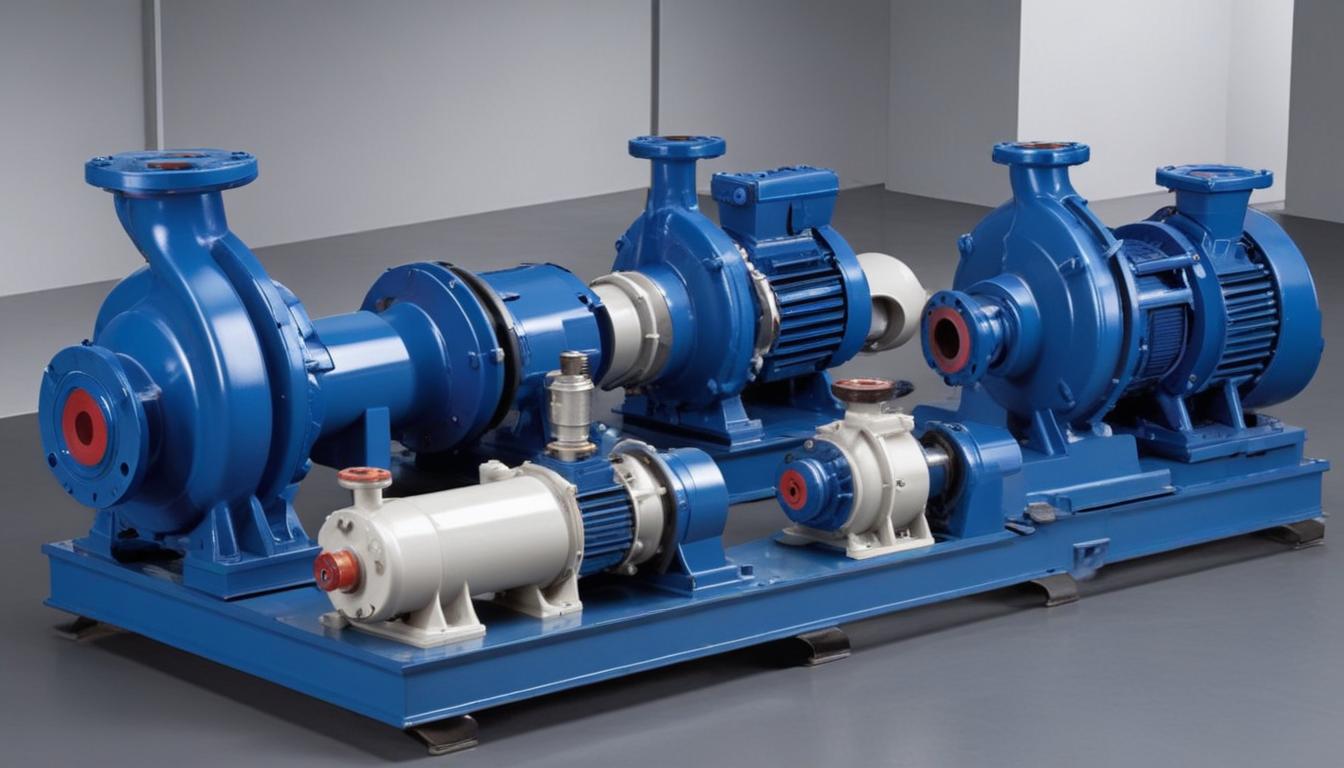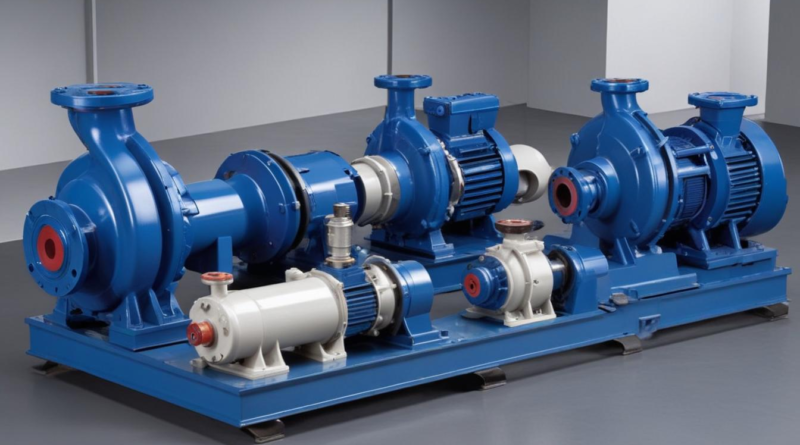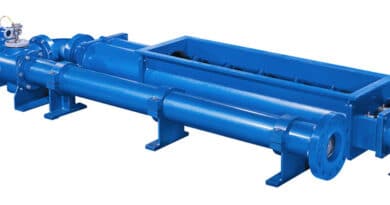how to choose a pump based on fluid properties
The selection of an appropriate pump is heavily influenced by the fluid properties involved in the application. A comprehensive understanding of these properties ensures that the pump operates efficiently and reliably under varying conditions. Key criteria to consider include:
- Viscosity: Determines the fluid’s resistance to flow, impacting the type of pump suitable for handling it.
- Density: Influences the pump’s power requirements and energy consumption.
- Temperature: Affects the pump materials and seals, ensuring longevity and performance.
- Corrosiveness: Dictates the selection of materials to prevent degradation and contamination.
- Solid Content: Determines whether the pump needs to handle particulates or slurries, influencing the design.
Understanding these properties allows for informed decisions during pump selection, ensuring compatibility and maximizing operational efficiency. The following table outlines common fluid properties and their impact on pump choice:
| Fluid Property | Impact on Pump Selection | Considerations |
|---|---|---|
| Viscosity | High viscosity requires pumps with higher torque and specific designs such as positive displacement pumps. | Temperature variations can alter viscosity, necessitating pumps that can adapt or maintain performance. |
| Density | Affects the energy required to move the fluid, influencing pump sizing and motor selection. | Ensure the pump can handle the weight of the fluid without excessive wear. |
| Temperature | High temperatures may require pumps made from materials that can withstand thermal stress. | Seals and gaskets must be compatible with the operating temperature range. |
| Corrosiveness | Pumps must be constructed from materials resistant to the specific chemicals in the fluid. | Regular maintenance may be needed to address potential material degradation. |
| Solid Content | Presence of solids may necessitate specialized impellers or clearance designs to prevent clogging. | Consideration of wear-resistant materials to handle abrasive particles. |
By meticulously evaluating these fluid properties, engineers can select pumps that not only meet the immediate requirements but also ensure durability and efficiency over the long term.
types of pumps and their applications
Selecting the right pump type is pivotal in ensuring efficient handling of various fluids across different applications. Each pump type is designed to accommodate specific fluid properties and operational requirements. Understanding the characteristics and suitable applications of each pump type can significantly enhance pump selection criteria.
Positive Displacement Pumps are ideal for applications requiring precise flow control and the ability to handle high-viscosity fluids. These pumps operate by trapping a fixed amount of fluid and transporting it through the pump mechanism. Common types include:
- Gear Pumps: Suitable for lubricating systems and hydraulic applications due to their ability to handle oils and other high-viscosity fluids.
- Piston Pumps: Used in high-pressure applications such as water jet cutting and injection molding.
- Diaphragm Pumps: Ideal for handling corrosive and abrasive fluids in chemical processing and wastewater treatment.
Centrifugal Pumps are widely used for their ability to handle large volumes of low to medium viscosity fluids. They operate by converting rotational kinetic energy to hydrodynamic energy. Key applications include:
- Water Supply Systems: Providing water for municipal and residential use.
- Cooling Systems: Circulating coolant in industrial machinery and engines.
- Sewage Treatment: Transporting wastewater through treatment facilities.
The following table summarizes the primary pump types and their typical applications:
| Pump Type | Key Fluid Properties Handled | Common Applications |
|---|---|---|
| Gear Pumps | High viscosity, lubricating oils | Hydraulic systems, lubrication systems |
| Piston Pumps | High pressure, precise flow control | Water jetting, injection molding |
| Diaphragm Pumps | Corrosive, abrasive fluids | Chemical processing, wastewater treatment |
| Centrifugal Pumps | Low to medium viscosity, large volumes | Water supply, cooling systems, sewage |
| Peristaltic Pumps | Viscous and shear-sensitive fluids | Medical applications, food and beverage processing |
| Screw Pumps | High viscosity, slurry handling | Agricultural processing, mining operations |
Specialized Pump Types cater to unique fluid handling requirements. For instance:
- Magnetic Drive Pumps: Utilize a magnetic coupling to prevent leaks, making them suitable for handling hazardous or toxic fluids.
- Sanitary Pumps: Designed with smooth surfaces and hygienic materials for use in the food, beverage, and pharmaceutical industries.
- Submersible Pumps: Operate while submerged in the fluid, commonly used in drainage, sump, and well applications.
When evaluating pump types, it’s essential to consider not only the fluid properties but also the specific requirements of the application, such as flow rate, pressure, and environmental conditions. By aligning the pump type with these criteria, optimal performance and longevity can be achieved.
selecting pump based on viscosity
Viscosity is a critical factor in determining the appropriate pump type for a specific application. It measures a fluid’s resistance to flow, directly impacting the pump’s ability to move the fluid efficiently. High-viscosity fluids, such as oils and syrups, require pumps that can generate sufficient torque and maintain consistent flow rates, while low-viscosity fluids, like water, allow for a broader range of pump options.
When selecting a pump based on viscosity, consider the following key criteria:
- Shear Sensitivity: Fluids that are shear-sensitive may require gentle pumping mechanisms to prevent degradation or changes in properties.
- Flow Rate Requirements: The desired flow rate influences the pump’s capacity to handle viscous fluids without excessive energy consumption.
- Operating Pressure: Higher viscosity fluids often necessitate pumps that can operate under higher pressures to achieve the required flow rates.
- Temperature Effects: Viscosity can vary with temperature, so selecting a pump that can adapt to these changes is essential for maintaining performance.
Pump Types Suitable for Viscosity Variations
Different pump types are optimized to handle specific viscosity ranges effectively. Understanding these distinctions is crucial for making an informed pump selection.
| Pump Type | Suitable Viscosity Range | Key Features |
|---|---|---|
| Gear Pumps | High viscosity fluids | Positive displacement action, precise flow control, handles lubricating oils and thick chemicals |
| Centrifugal Pumps | Low to medium viscosity fluids | High flow rates, energy-efficient for water and light liquids, continuous operation |
| Diaphragm Pumps | Medium to high viscosity fluids | Handles corrosive and abrasive fluids, maintains flow despite viscosity changes, leak-free operation |
| Screw Pumps | High viscosity and slurry | Efficient handling of thick and particulate-laden fluids, minimal pulsation, suitable for continuous flow |
| Peristaltic Pumps | Low to medium viscosity fluids | Gentle pumping action, ideal for shear-sensitive fluids, easy maintenance |
Calculating Pump Requirements for Viscous Fluids
To ensure optimal performance when dealing with viscous fluids, it is essential to accurately calculate the pump requirements. The following formula can assist in determining the necessary pump capacity:
- Determine the Desired Flow Rate: Establish the required volume of fluid to be moved per unit time (e.g., gallons per minute).
- Assess the Fluid’s Viscosity: Measure the viscosity, typically in centipoise (cP), to understand the resistance the pump must overcome.
- Calculate the Total Dynamic Head (TDH): Consider factors such as elevation, friction losses, and pressure requirements to determine the total head the pump needs to achieve.
- Select a Pump with Appropriate Torque and Power: Ensure the chosen pump can handle the calculated TDH and flow rate, taking into account the fluid’s viscosity.
Impact of Viscosity on Pump Efficiency and Maintenance
Higher viscosity fluids can lead to increased wear and tear on pump components due to the greater force required to move the fluid. This can affect both the efficiency and the maintenance schedule of the pump system. Selecting a pump designed for high-viscosity applications can mitigate these issues, ensuring longer pump life and consistent performance.
- Material Selection: Pumps handling high-viscosity fluids should be constructed from durable materials that resist abrasion and wear.
- Seal Integrity: Effective sealing mechanisms are crucial to prevent leaks, especially when pumping thick or sticky fluids.
- Lubrication: Proper lubrication of moving parts can reduce friction and prevent overheating, enhancing pump longevity.
- Regular Maintenance: Implementing a routine maintenance schedule helps identify and address wear-related issues before they lead to pump failure.
By thoughtfully considering viscosity alongside other fluid properties and pump selection criteria, engineers can ensure the chosen pump will perform reliably and efficiently within the intended application.
considering temperature and corrosiveness
 Temperature and corrosiveness are critical factors that significantly influence the pump selection process. Proper consideration of these aspects ensures the pump operates reliably and maintains its integrity over its intended lifespan. Addressing both temperature and corrosiveness involves selecting appropriate materials, seals, and design features that can withstand the operating conditions without compromising performance.
Temperature and corrosiveness are critical factors that significantly influence the pump selection process. Proper consideration of these aspects ensures the pump operates reliably and maintains its integrity over its intended lifespan. Addressing both temperature and corrosiveness involves selecting appropriate materials, seals, and design features that can withstand the operating conditions without compromising performance.
- Temperature Considerations: The operating temperature of the fluid affects the choice of pump materials, seals, and overall design. High temperatures can lead to thermal expansion, material degradation, and reduced seal integrity, while low temperatures may cause materials to become brittle and seals to harden.
- Corrosiveness Considerations: Corrosive fluids can deteriorate pump components, leading to leaks, reduced efficiency, and premature failure. Selecting materials that resist corrosion is essential to ensure the longevity and reliability of the pump.
Material Selection for Temperature and Corrosiveness
Choosing the right materials is paramount when dealing with fluids that present extreme temperatures or corrosive properties. The following table outlines common materials used in pump construction and their suitability for various temperature ranges and corrosive environments:
| Material | Temperature Range | Corrosion Resistance | Common Applications |
|---|---|---|---|
| Stainless Steel | -20°F to 500°F | High resistance to many chemicals and oxidation | Chemical processing, food and beverage, pharmaceuticals |
| Hastelloy | -10°F to 1500°F | Exceptional resistance to a wide range of corrosive agents | Severe chemical environments, offshore applications |
| PTFE (Teflon) | -200°F to 500°F | Excellent chemical inertness | Handling highly corrosive fluids, linings for diaphragm pumps |
| Carbon Steel | -40°F to 400°F | Moderate resistance, requires coating for corrosive fluids | Water pumping, HVAC systems, general industrial use |
| Monel | -100°F to 800°F | Good resistance to seawater and many acids | Marine applications, chemical processing |
Seal Selection
Seals play a vital role in maintaining pump integrity, especially under varying temperature and corrosive conditions. The appropriate seal material must be chosen based on the fluid’s properties and the operating environment to prevent leaks and ensure efficient operation.
- Elastomer Seals: Suitable for moderate temperatures and non-extreme corrosive conditions. Common materials include nitrile rubber (NBR) for oils and silicone for wider temperature ranges.
- PTFE Seals: Ideal for high-temperature and highly corrosive fluids due to their excellent chemical resistance and thermal stability.
- Metal Seals: Used in extreme conditions where elastomer seals may fail. These are typically employed in high-temperature and highly corrosive environments.
Design Features to Mitigate Temperature and Corrosiveness Effects
Incorporating specific design features can enhance the pump’s ability to handle challenging fluid properties related to temperature and corrosiveness.
- Thermal Protection: Insulating materials or cooling systems can be integrated to manage high-temperature operations and prevent overheating of pump components.
- Corrosion-Resistant Coatings: Applying protective coatings to pump surfaces can shield against corrosive fluids, extending the pump’s service life.
- Appropriate Ventilation: Ensuring proper ventilation can help dissipate heat and reduce the risk of thermal degradation in pump components.
- Flexible Connections: Utilizing flexible piping connections can accommodate thermal expansion and contraction, preventing undue stress on pump joints and seals.
Criteria for Selecting Pumps Based on Temperature and Corrosiveness
When evaluating pumps for applications involving extreme temperatures or corrosive fluids, the following criteria should be meticulously assessed:
- Material Compatibility: Ensure that all pump materials are compatible with the fluid’s chemical composition and can withstand the operating temperature range.
- Seal Integrity: Select seals that maintain their properties under the expected temperature and corrosive conditions to prevent leaks.
- Thermal Management: Incorporate design elements that address heat generation and dissipation to maintain optimal pump performance.
- Maintenance Requirements: Choose pumps that allow for easy maintenance and replacement of components exposed to harsh conditions.
- Regulatory Compliance: Verify that the pump meets industry standards and regulations related to handling specific fluids under certain temperature and corrosiveness parameters.
By thoroughly analyzing the temperature and corrosiveness of the fluids, and aligning these factors with the appropriate materials and design considerations, engineers can make informed decisions that enhance pump reliability and efficiency in demanding applications.
evaluating pump performance and efficiency
Evaluating the performance and efficiency of a pump is essential to ensure it meets the operational demands while optimizing energy usage and minimizing costs. This assessment involves analyzing various parameters that reflect how well a pump handles specific fluid properties and adheres to the defined criteria for the application. Key factors to consider include flow rate, head, efficiency, power consumption, and the pump’s ability to maintain performance under varying conditions.
Key Performance Parameters
- Flow Rate: The volume of fluid a pump can deliver over a specific period, typically measured in gallons per minute (GPM) or liters per second (L/s). It is crucial to match the pump’s flow rate with the system’s requirements to ensure adequate fluid movement without overworking the pump.
- Head: Represents the height to which a pump can raise the fluid, measured in feet or meters. Total Dynamic Head (TDH) accounts for both the static lift and the friction losses within the piping system.
- Efficiency: Indicates how effectively a pump converts electrical power into hydraulic power. Higher efficiency reduces energy consumption and operational costs. Efficiency is influenced by the pump design, impeller type, and operating conditions.
- Power Consumption: The amount of electrical energy required to operate the pump, measured in horsepower (HP) or kilowatts (kW). Selecting a pump with optimal power requirements ensures cost-effective operation.
- Net Positive Suction Head (NPSH): Ensures that the pump operates without cavitation by maintaining adequate pressure at the suction inlet. Proper NPSH prevents damage to the pump and maintains fluid integrity.
Performance Curves Analysis
Performance curves are graphical representations that illustrate a pump’s behavior under different operating conditions. They are essential tools for comparing pump performance and making informed pump selection decisions. The primary curves include:
- Head vs. Flow Rate: Shows the relationship between the flow rate and the head. It helps identify the pump’s operating point where the required flow and head intersect.
- Efficiency Curve: Displays the pump’s efficiency at various flow rates. The peak of this curve indicates the most efficient operating condition.
- Power Consumption Curve: Illustrates how power usage varies with flow rate. Understanding this relationship aids in selecting pumps that operate efficiently within the desired range.
Table 1: Example of Pump Performance Curves
| Flow Rate (GPM) | Head (ft) | Efficiency (%) | Power (HP) |
|---|---|---|---|
| 50 | 100 | 70 | 15 |
| 100 | 90 | 75 | 18 |
| 150 | 80 | 78 | 20 |
| 200 | 70 | 76 | 22 |
Evaluating Efficiency and Energy Consumption
Maximizing pump efficiency is vital for reducing operational costs and minimizing environmental impact. To evaluate and enhance efficiency:
- Match Pump to System Curve: Ensure the pump operates near its best efficiency point (BEP) by aligning it with the system’s flow and head requirements.
- Variable Speed Drives (VSDs): Implementing VSDs allows for adjusting the pump speed to match varying demand, enhancing efficiency and reducing energy consumption.
- Regular Maintenance: Keeping the pump in optimal condition through routine maintenance prevents efficiency losses due to wear and tear, fouling, or misalignment.
- Impeller Selection: Choosing the appropriate impeller design for the specific fluid properties can significantly improve hydraulic efficiency.
Energy Efficiency Considerations
Energy efficiency not only impacts operational costs but also aligns with sustainability goals. When evaluating pumps for energy efficiency:
- Motor Efficiency: Select high-efficiency motors that consume less power for the same output.
- Advanced Materials: Utilize materials that reduce friction and wear, contributing to sustained efficiency over time.
- System Optimization: Optimize the entire pumping system, including piping layout and valving, to reduce unnecessary pressure drops and energy losses.
Reliability and Maintenance Impact on Performance
A reliable pump maintains consistent performance and minimizes downtime. Factors influencing reliability include:
- Quality of Components: High-quality bearings, seals, and impellers enhance durability and reduce the likelihood of failures.
- Design Robustness: Pumps designed to withstand the specific fluid properties and operating conditions of the application are less prone to performance degradation.
- Ease of Maintenance: Pumps that allow easy access to critical components facilitate timely maintenance, ensuring sustained performance and efficiency.
Table 2: Comparison of Pump Reliability Factors
| Factor | High Reliability | Impact on Performance |
|---|---|---|
| Component Quality | Use of premium materials and precision manufacturing | Reduces breakdowns and maintains efficiency |
| Design Suitability | Engineered for specific fluid properties and conditions | Ensures optimal performance and longevity |
| Maintenance Accessibility | Easy access to wear parts and service points | Facilitates regular maintenance, preventing performance issues |
| Redundancy Features | Incorporation of backup systems or fail-safes | Enhances operational continuity and reliability |
By meticulously evaluating these performance and efficiency parameters, engineers and decision-makers can select pumps that not only meet the immediate operational needs but also provide long-term reliability and cost-effectiveness. This comprehensive approach to pump evaluation ensures that the selected equipment will perform optimally within the specified criteria, accommodating the unique fluid properties of the application.




